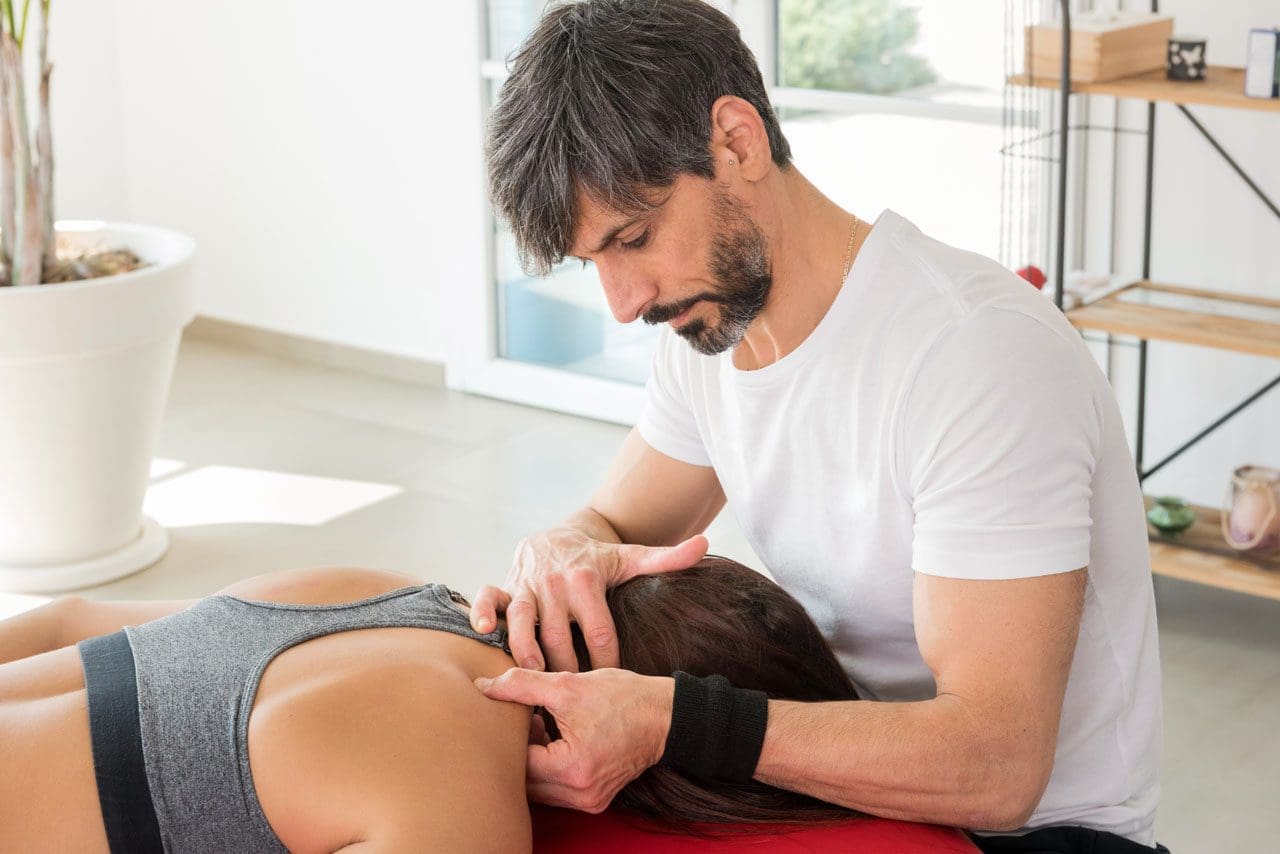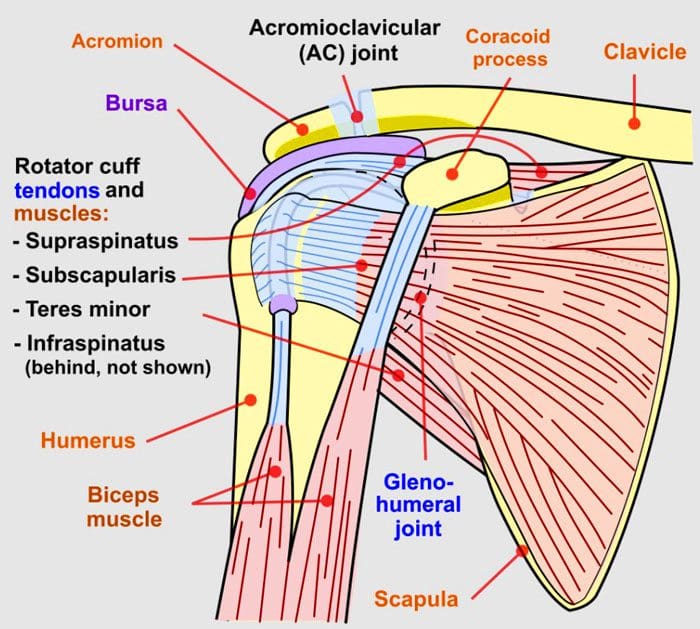
There are various causes for achiness or soreness under the shoulder blades. The shoulder blade is the triangular bone that forms the back of the shoulder. This pain can range from dull, sharp, burning, or a combination between the spine and shoulder blade to tender or achy across the shoulder or upper back. Pain can spread from another body part or structure, like the neck or spine. Inflammation from injury or overuse is noticeable at onset or gradually after engaging in physical activity and can limit arm movements and interfere with regular activities.

Table of Contents
Improper Posture
Improper poster combined with prolonged sitting can cause the spine to develop structural changes that cause pain under the shoulder blade. Habits that lead to poor posture include:
- Hunching the back.
- Tilting the head down – looking at the phone.
- Leaning to one side while sitting, working.
Poor posture habits cause the muscles to weaken, placing added pressure on the spinal discs, muscles, and ligaments. This body imbalance can contribute to upper back and shoulder pain.
Lifting Improperly
Lifting weight above the head and not using the proper technique can leave the upper back and shoulders vulnerable to injury. Lifting an object that is too heavy or is held in an awkward way causing the spine to be misaligned creates added pressure in the upper back. This can strain the muscles, sprain ligaments, injure the shoulder joint, or spine, which can cause spreading pain under and/or near the shoulder blade.
Repetitive Overuse Injury
Painting, moving furniture, or participating in sports are activities that can overwork the upper back muscles and shoulders. Overuse can lead to muscle strains and ligament sprains. This can cause pain in the upper back between the shoulder blade and the spine. Scapulothoracic bursitis, also known as snapping scapula syndrome, is when the bursa between the shoulder blade/scapula and the thoracic spine becomes inflamed, causing pain.
Cervical Herniated Disc
A herniated disc in the cervical spine/neck happens when a disc’s outer layer/annulus fibrosus tears and the inner layer/nucleus pulposus starts to leak outward. This can cause pain and cause the nearby nerve roots to become inflamed, causing pain to run down into the shoulder, arm, and/or hand. A disc herniation in the lower part of the neck usually radiates pain into or near the shoulder blade area. Although less common, a herniation in the upper back can cause pain around or near the shoulder blade.
Dislocated Rib
An accident or fall could cause a rib to become dislocated or misaligned after repetitive/overuse strain or reaching too far overhead. Sharp pain near the shoulder blade can result from this activity and can sometimes make it challenging to take a deep breath.
Compression Fracture
A compression fracture occurs when a vertebral bone in the upper back weakens and compresses. This can lead to back pain with a heightened sensitivity across the shoulder area. The pain usually decreases with rest. Compression fractures are commonly caused by osteoporosis in older individuals. Any back or shoulder pain that persists for weeks or interferes with regular activities should be evaluated by a doctor or chiropractor. If the pain is severe or accompanied by symptoms like headache, tingling, weakness, or nausea, individuals are recommended to seek medical attention.
Body Composition
Carbohydrate/Carb Loading
Carbohydrates are macronutrients that serve a critical function in the body, as they are the body’s primary energy source. The body breaks down carbohydrates into sugar that enters the bloodstream and is stored for energy use in the muscles and liver as glycogen. The muscles only store small quantities of glycogen. And when engaging in physical activity or exercise, the energy stores get used up.
Carbohydrate loading can raise glycogen stores in the muscles from 25 to 100 percent of their average amount in men. Women have shown mixed results in studies on carbohydrate loading. Women need to take in more calories than men when carb-loading to experience the same gains in glycogen. Reasons to carb load are either to:
- Build-up stores of glycogen so an individual can use the extra energy storage to help improve endurance.
- Fill the muscles with glycogen to bring water into the muscles to help gain mass and tone.
References
Hanchard, Nigel C A et al. “Physical tests for shoulder impingements and local lesions of bursa, tendon or labrum that may accompany impingement.†The Cochrane database of systematic reviews vol. 2013,4 CD007427. 30 Apr. 2013, doi:10.1002/14651858.CD007427.pub2
Mizutamari M. et al. Corresponding scapular pain with the nerve root involved in cervical radiculopathy. J Orthop Surg. 2010; 18(3): 356–60.
Sergienko, Stanislav, and Leonid Kalichman. “Myofascial origin of shoulder pain: a literature review.†Journal of bodywork and movement therapies vol. 19,1 (2015): 91-101. doi:10.1016/j.jbmt.2014.05.004
Disclaimers
Professional Scope of Practice *
The information herein on "Pain Under The Shoulder Blade" is not intended to replace a one-on-one relationship with a qualified health care professional or licensed physician and is not medical advice. We encourage you to make healthcare decisions based on your research and partnership with a qualified healthcare professional.
Blog Information & Scope Discussions
Welcome to El Paso's wellness blog, where Dr. Alex Jimenez, DC, FNP-C, a board-certified Family Practice Nurse Practitioner (FNP-C) and Chiropractor (DC), presents insights on how our team is dedicated to holistic healing and personalized care. Our practice aligns with evidence-based treatment protocols inspired by integrative medicine principles, similar to those found on dralexjimenez.com, focusing on restoring health naturally for patients of all ages.
Our areas of chiropractic practice include Wellness & Nutrition, Chronic Pain, Personal Injury, Auto Accident Care, Work Injuries, Back Injury, Low Back Pain, Neck Pain, Migraine Headaches, Sports Injuries, Severe Sciatica, Scoliosis, Complex Herniated Discs, Fibromyalgia, Chronic Pain, Complex Injuries, Stress Management, Functional Medicine Treatments, and in-scope care protocols.
Our information scope is limited to chiropractic, musculoskeletal, physical medicine, wellness, contributing etiological viscerosomatic disturbances within clinical presentations, associated somato-visceral reflex clinical dynamics, subluxation complexes, sensitive health issues, and functional medicine articles, topics, and discussions.
We provide and present clinical collaboration with specialists from various disciplines. Each specialist is governed by their professional scope of practice and their jurisdiction of licensure. We use functional health & wellness protocols to treat and support care for the injuries or disorders of the musculoskeletal system.
Our videos, posts, topics, subjects, and insights cover clinical matters, issues, and topics that relate to and directly or indirectly support our clinical scope of practice.*
Our office has reasonably attempted to provide supportive citations and has identified the relevant research studies or studies supporting our posts. We provide copies of supporting research studies available to regulatory boards and the public upon request.
We understand that we cover matters that require an additional explanation of how they may assist in a particular care plan or treatment protocol; therefore, to discuss the subject matter above further, please feel free to ask Dr. Alex Jimenez, DC, APRN, FNP-BC, or contact us at 915-850-0900.
We are here to help you and your family.
Blessings
Dr. Alex Jimenez DC, MSACP, APRN, FNP-BC*, CCST, IFMCP, CFMP, ATN
email: coach@elpasofunctionalmedicine.com
Licensed as a Doctor of Chiropractic (DC) in Texas & New Mexico*
Texas DC License # TX5807
New Mexico DC License # NM-DC2182
Licensed as a Registered Nurse (RN*) in Texas & Multistate
Texas RN License # 1191402
ANCC FNP-BC: Board Certified Nurse Practitioner*
Compact Status: Multi-State License: Authorized to Practice in 40 States*
Graduate with Honors: ICHS: MSN-FNP (Family Nurse Practitioner Program)
Degree Granted. Master's in Family Practice MSN Diploma (Cum Laude)
Dr. Alex Jimenez, DC, APRN, FNP-BC*, CFMP, IFMCP, ATN, CCST
My Digital Business Card
